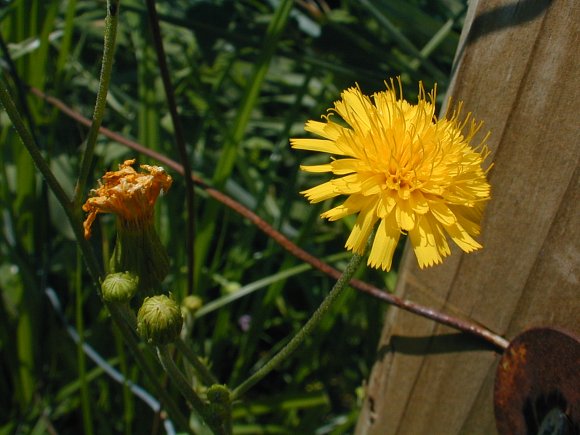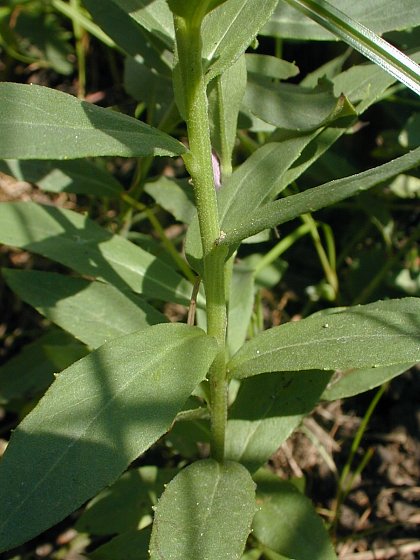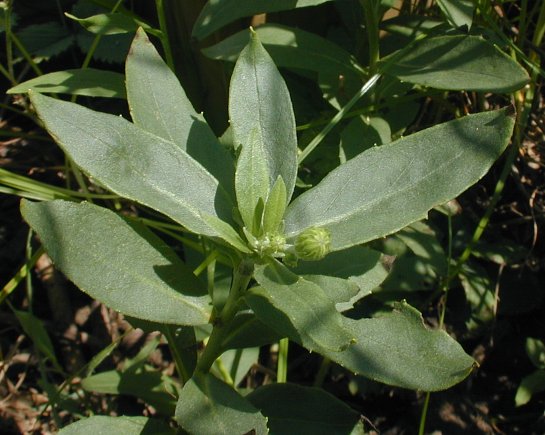
The central stem terminates in a panicle of flowerheads that is often corymb-like in shape; a large panicle may have more than one corymb-like division. The size of these panicles is 3-20" long and 5-10" across; small panicles are sometimes more wide than they are across, while large panicles are longer in length than they are across. The branches of each panicle are light green, terete, short-pubescent, and largely naked; a few leafy bracts up to ¼" long may be present. The terminal branches produce individual flowerheads about ¾-1¼" across. Each flowerhead has 30-80 ray florets and no disk florets. The petaloid extensions (or rays) of these florets are bright yellow and narrowly oblong in shape; their tips are 5-toothed and truncate. The base of each flowerhead is surrounded by narrow green phyllaries in 2-3 series. The outermost phyllaries are the smallest. These phyllaries are glabrous or short-hairy; sometimes they have short glandular hairs. The blooming period occurs from mid-summer to early fall, lasting about 3-4 weeks for a colony of plants. In the absence of cross-pollination from other plants, the florets are self-fertile. Shortly afterwards, the florets are replaced by small achenes with sessile tufts of light brown hair. The achenes are about 2.5–3 mm. in length, bullet-shaped, ribbed along their sides, and truncate at their apices. They are distributed by the wind. The root system is fibrous, sometimes forming clonal offsets. On older plants, a small caudex may develop.

Cultivation: The preference is full sun to light shade, mesic to dry conditions, and either sandy or rocky soil. This plant dislikes hot summer weather (90°F or higher temperatures). Plant size can vary considerably depending on the habitat, weather, and local ecotype.
Range & Habitat: Northern Hawkweed is occasional in northern Illinois, where it is native (see Distribution Map). It also occurs in Eurasia, although the latter continental mass has varieties that are distinct from those in North America. Habitats include sandy upland savannas, sand prairies, stabilized sand dunes, openings in sandy or rocky woodlands, sandy thickets, sandy fields, and roadsides. Northern Hawkweed can be found in either high quality or disturbed habitats. It probably benefits from occasional wildfires if this reduces competing woody vegetation.
Faunal Associations: Various bees and probably other insects visit the flowerheads for nectar and/or pollen, including Halictid bees. Some aphids suck plant juices from the flowering stems and other parts of hawkweeds (Hieracium spp.); these species include Hyperomyzus inflatus, Nasonovia ribisnigri (Currant-Lettuce Aphid), Uroleucon hieracicola (Hawkweed Aphid), and Uroleucon sonchi (Sow-Thistle Aphid). Another insect, the plant bug Lygus rubroclarus, feeds on hawkweeds and other members of the Aster family. These plants are also suspected hosts of Schinia bina (Bina Flower Moth). Among vertebrate animals, the Ruffed Grouse and Wild Turkey eat the seeds and leaves of hawkweeds to some extent; the Cottontail Rabbit and White-Tailed Deer also browse on the leaves (Martin et al., 1951/1961).

Photographic Location: The wildflower garden of the webmaster in Urbana, Illinois.
Comments: Northern Hawkweed is one of the showier native hawkweeds (Hieracium spp.) because it has larger flowerheads (about 1" across) than most. It also produces more leaves along its stems, and the branches of its inflorescence are short-pubescent, rather than glandular-hairy. The taxonomy of this hawkweed, at least in North America, is somewhat confused. In addition to Hieracium umbellatum (Northern Hawkweed), this plant is also referred to as Hieracium canadense (Canada Hawkweed) and Hieracium kalmii (Kalm's Hawkweed). The view taken here is that Hieracium umbellatum is a highly variable species that subsumes both Eurasian and North American plants. The primary difficulty in North America is that leaf width and the amount of dentition along leaf margins are highly variable. Populations of plants in northeastern United States and southeastern Canada tend to have wider leaves with more strongly defined teeth, while populations of plants in the upper midwest of the United States and south-central Canada tend to have more narrow leaves with poorly defined teeth. In Eurasia, this plant tends to have even more narrow leaves than what is observed in North America. These and other variations have led to the description of different varieties and subspecies that have varied in their popularity across time. Another common name of Hieracium umbellatum is Narrow-Leaved Hawkweed.